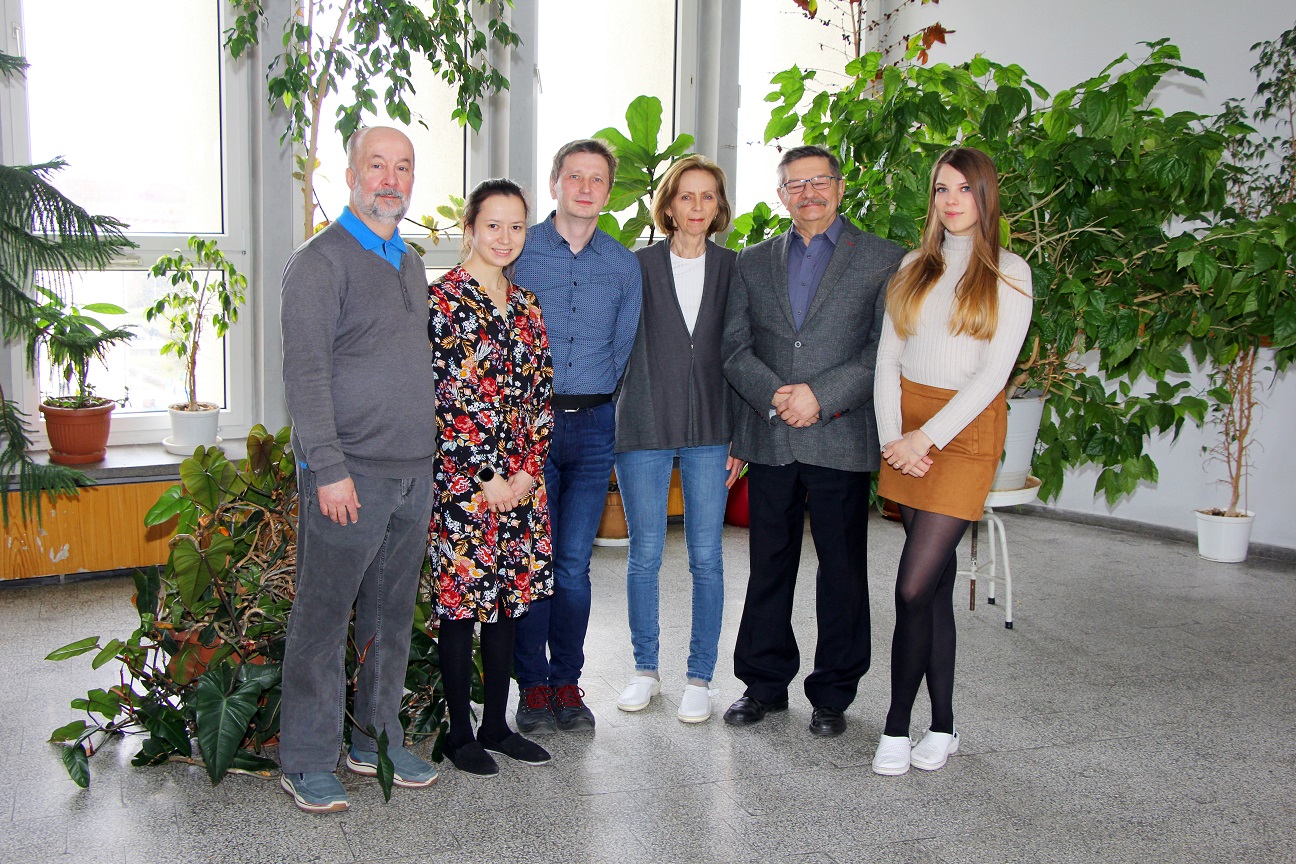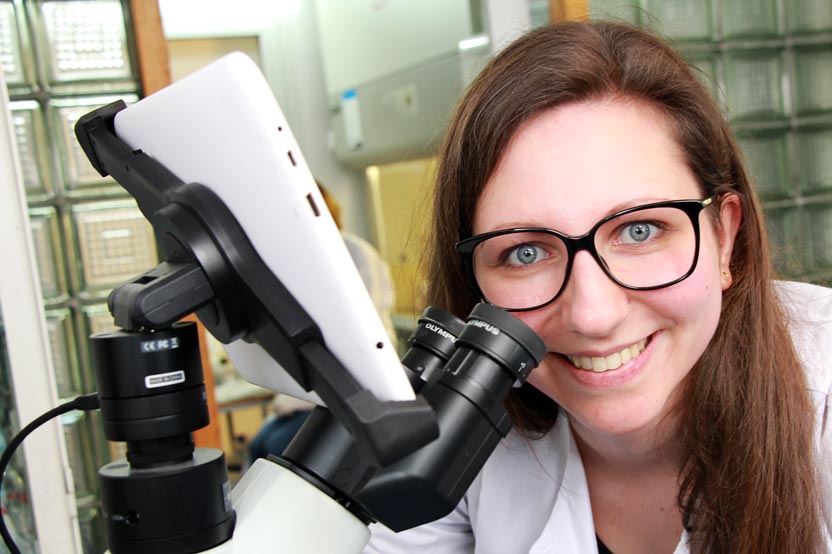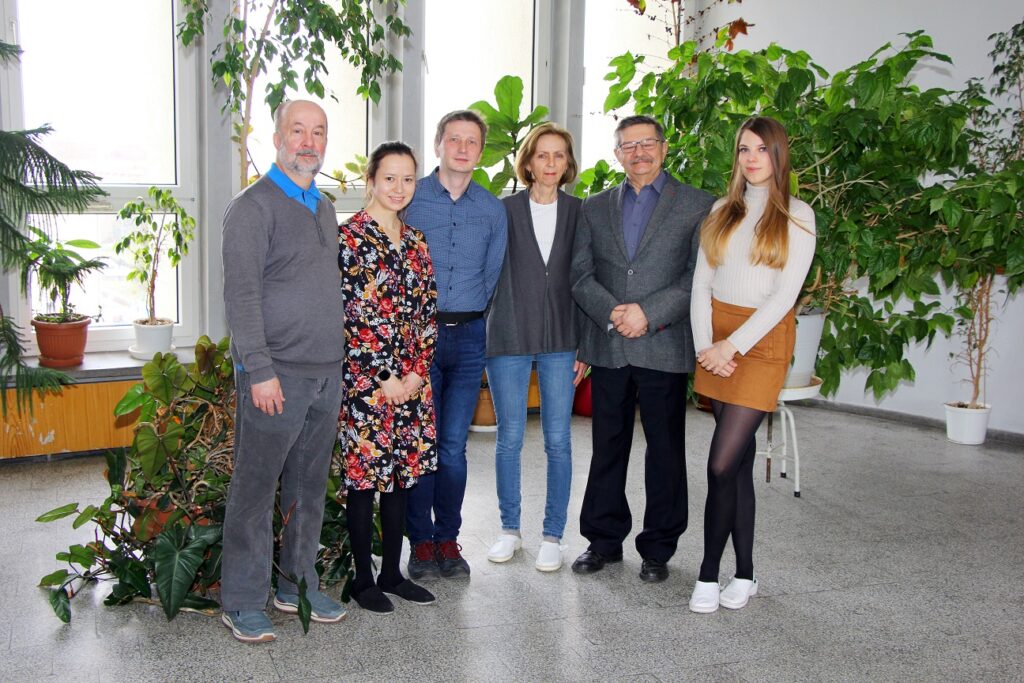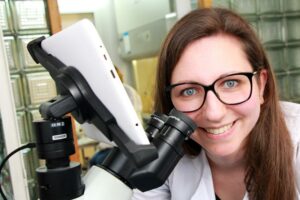 From the time of the foundation of our Laboratory by Prof. Leon Strzadala, our research group’s leading subject matter has been the study of molecular mechanisms of cell death in normal or cancer cells. Accordingly, our interests are focused on exploring mechanisms of action of anticancer or anti-inflammatory drugs. Recently, it led us to investigate unknown mechanisms of action of DNA methylation and topoisomerase inhibitors. Concurrently, we examine opportunities for using natural compounds like betulin and betulinic acid in anticancer therapy. We also performed a series of studies showing the cytotoxicity of nanoparticles against immune cells. We demonstrated its selective toxicity towards macrophages and discovered events that lead to the induction of cell death.
From the time of the foundation of our Laboratory by Prof. Leon Strzadala, our research group’s leading subject matter has been the study of molecular mechanisms of cell death in normal or cancer cells. Accordingly, our interests are focused on exploring mechanisms of action of anticancer or anti-inflammatory drugs. Recently, it led us to investigate unknown mechanisms of action of DNA methylation and topoisomerase inhibitors. Concurrently, we examine opportunities for using natural compounds like betulin and betulinic acid in anticancer therapy. We also performed a series of studies showing the cytotoxicity of nanoparticles against immune cells. We demonstrated its selective toxicity towards macrophages and discovered events that lead to the induction of cell death.
 Additionally, our Laboratory, namely Dr. Andrzej Rapak, is engaged in designing and implementing diagnostic tests based on polyclonal and monoclonal antibodies. Such tests are used to detect or measure antigens or antibodies in physiological fluids (urine, serum, or whole blood). In cooperation with BioWet Puławy, two of such ELISA diagnostic tools for screening dogs’ B-cell lymphomas and Enzootic Bovine Leucosis were patented and successfully implemented into veterinary practice.
Additionally, our Laboratory, namely Dr. Andrzej Rapak, is engaged in designing and implementing diagnostic tests based on polyclonal and monoclonal antibodies. Such tests are used to detect or measure antigens or antibodies in physiological fluids (urine, serum, or whole blood). In cooperation with BioWet Puławy, two of such ELISA diagnostic tools for screening dogs’ B-cell lymphomas and Enzootic Bovine Leucosis were patented and successfully implemented into veterinary practice.
We can take advantage of our practical knowledge of the methodology of cell death assessment in the studies of the biocompatibility of new materials: simple and complex nanoparticles, liposomes, or bioactive coatings that can be further applied in bioengineering. Because our team consists of people of diverse backgrounds, we can be part of multidisciplinary projects in the matter of medicine, chemistry, veterinary sciences, and material engineering.
Contact
Head
 Laboratory Head: dr hab. Wojciech Kałas, profesor PAN (http://orcid.org/0000-0003-2656-5192) Director’s biography: Dr. Hab Wojciech Kalas is an graduate of the Wrocław Technical University’s Chemical Department. He started work in Ludwik Hirszfeld’s Institute of Immunology and Experimental Therapy in 1997, where in 2000, he was awarded a Ph.D. in biological sciences. 2003-2007, he had a postdoctoral fellowship at McMaster University Hamilton, ON, CA, at Prof. Janusz Rak’s Laboratory. At that time, he studied the regulation of angiogenesis by Ras-transformed cancer cells. 2012-2018 he lectured on Jan Długosz’s Univeristy in Częstochowa. In his scientific life, Dr. Wojciech Kałas concentrates on cancer research regarding the mechanisms of action of anticancer drugs and methods of early detection of chemoresistance. He led 3 NCN grants and participated in several other projects. He is a co-author of 42 publications in indexed scientific journals. Privately and professionally, he loves new challenges.
Laboratory Head: dr hab. Wojciech Kałas, profesor PAN (http://orcid.org/0000-0003-2656-5192) Director’s biography: Dr. Hab Wojciech Kalas is an graduate of the Wrocław Technical University’s Chemical Department. He started work in Ludwik Hirszfeld’s Institute of Immunology and Experimental Therapy in 1997, where in 2000, he was awarded a Ph.D. in biological sciences. 2003-2007, he had a postdoctoral fellowship at McMaster University Hamilton, ON, CA, at Prof. Janusz Rak’s Laboratory. At that time, he studied the regulation of angiogenesis by Ras-transformed cancer cells. 2012-2018 he lectured on Jan Długosz’s Univeristy in Częstochowa. In his scientific life, Dr. Wojciech Kałas concentrates on cancer research regarding the mechanisms of action of anticancer drugs and methods of early detection of chemoresistance. He led 3 NCN grants and participated in several other projects. He is a co-author of 42 publications in indexed scientific journals. Privately and professionally, he loves new challenges.
Research team
Assistant professors:
Lecturer:
Technical:
PhD students:
The most important 3 scientific achievements
- Test for Enzootic Bovine Leucosis
- Discovery of separate mechanisms of action of azacitidine and decitabine
- Description of toxicity mechanism of lanthanide nanoparticles
Research methods
-
molecular biology, assessment of cell death, NK cells activity assessment, gene and protein expression, non-standard cytometry
The most important research projects (last 10 years)
- Projekt grantowy NCN OPUS nr 2017/25/B/NZ5/02608, Termin realizacji: 9.030.2018–8.03.2021 Tytuł: „Molekularny mechanizm działania i ocena efektu terapeutycznego kombinacji 5-aza-2’deoksycytydyny i inhibitorów topoizomeraz w leczeniu raka okrężnicy”Kierownik projektu: dr hab. Wojciech Kałas,
- Projekt badawczy NCBR PBS3/B8/20/2015 pt.: ”Opracowanie prostego i szybkiego testu polowego do wykrywania enzootycznej białaczki bydła.”
- Projekt badawczy NCBR PBS2/A8/27/2014 pt.: ”Opracowanie i ocena właściwości biologicznych antygenów cirkowirusa świń typu2 (PCV2) w aspekcie przydatności do produkcji szczepionki i zestawu diagnostycznego.”
- Projekt badawczy NCN 2014/15/B/NZ7/000867 pt.: “Ocena przydatności terapeutycznej wybranych azafenotiazyn oraz badanie mechanizmu ich aktywności immunosupresyjnej.”
- Projekt badawczy NCN 2013/09/B/NZ5/02764 pt.: “Fotoaktywna formulacja nanoliposomowa jako nowa strategia w terapii fotodynamicznej niestabilnej blaszki miażdżycowej”.
Selected peer review papers
-
Grudzien M, Pawlak A, Kutkowska J, Ziolo E, Wysokińska E, Hildebrand W, Obmińska-Mrukowicz B, Strzadala L, Rapak A. A newly established canine NK-type cell line and its cytotoxic properties. Vet Comp Oncol. 2021 Sep;19(3):567-577. doi: 10.1111/vco.12695. Epub 2021 Apr 26. PMID: 33774906.
-
Grudzien M, Rapak A. Effect of Natural Compounds on NK Cell Activation. J Immunol Res. 2018 Dec 25;2018:4868417. doi: 10.1155/2018/4868417. PMID:30671486; PMCID: PMC6323526.
-
Tarasiuk K, Holec-Gąsior L, Ferra B, Rapak A. The development of an indirect ELISA for the detection of goose parvovirus antibodies using specific VP3 subunits as the coating antigen. BMC Vet Res. 2019 Aug 1;15(1):274. doi: 10.1186/s12917-019-2027-1. PMID: 31370852; PMCID: PMC6676559.
-
Pawlak A, Ziolo E, Kutkowska J, Blazejczyk A, Wietrzyk J, Krupa A, Hildebrand W, Dziegiel P, Dzimira S, Obminska-Mrukowicz B, Strzadala L, Rapak A. A novel canine B-cell leukaemia cell line. Establishment, characterisation and sensitivity to chemotherapeutics. Vet Comp Oncol. 2017 Dec;15(4):1218-1231. Doi: 10.1111/vco.12257. Epub 2016 Aug 9. PMID: 27506920.
-
Lisowska M, Milczarek M, Ciekot J, Kutkowska J, Hildebrand W, Rapak A, Miazek A. An Antibody Specific for the Dog Leukocyte Antigen DR (DLA-DR) and Its Novel Methotrexate Conjugate Inhibit the Growth of Canine B Cell Lymphoma. Cancers (Basel). 2019 Sep 26;11(10):1438. doi: 10.3390/cancers11101438. PMID: 31561563; PMCID: PMC6827003.
-
Pawlak A, Chybicka K, Zioło E, Strządała L, Kałas W. The Contrasting Delayed Effects of Transient Exposure of Colorectal Cancer Cells to Decitabine or Azacitidine. Cancers (Basel). 2022 Mar 16;14(6):1530. doi: 10.3390/cancers14061530. PMID: 35326680; PMCID: PMC8945888.
-
Kaczorowska A, Lamperska W, Frączkowska K, Masajada J, Drobczyński S, Sobas M, Wróbel T, Chybicka K, Tarkowski R, Kraszewski S, Podbielska H, Kałas W, Kopaczyńska M. Profound Nanoscale Structural and Biomechanical Changes in DNA Helix upon Treatment with Anthracycline Drugs. Int J Mol Sci. 2020 Jun 10;21(11):4142. doi: 10.3390/ijms21114142. PMID: 32531996; PMCID: PMC7312087.
-
Pawlak A, Ziolo E, Fiedorowicz A, Fidyt K, Strzadala L, Kalas W. Long-lasting reduction in clonogenic potential of colorectal cancer cells by sequential treatments with 5-azanucleosides and topoisomerase inhibitors. BMC Cancer. 2016 Nov 16;16(1):893. doi: 10.1186/s12885-016-2925-6. PMID: 27852227; PMCID: PMC5112712.
-
Wysokińska E, Cichos J, Zioło E, Bednarkiewicz A, Strządała L, Karbowiak M, Hreniak D, Kałas W. Cytotoxic interactions of bare and coated NaGdF4:Yb(3+):Er(3+) nanoparticles with macrophage and fibroblast cells. Toxicol In Vitro. 2016 Apr;32:16-25. doi: 10.1016/j.tiv.2015.11.021. Epub 2015 Nov 27. PMID: 26639924.
-
Kałas W. Should Nano-Particles be Weighed or Counted? Technical Considerations to In Vitro Testing Originated from Corpuscular Nature of Nano-Particles. Arch Immunol Ther Exp (Warsz). 2021 Aug 3;69(1):23. doi: 10.1007/s00005-021-00623-8. PMID: 34345944; PMCID: PMC8332567.
 From the time of the foundation of our Laboratory by Prof. Leon Strzadala, our research group’s leading subject matter has been the study of molecular mechanisms of cell death in normal or cancer cells. Accordingly, our interests are focused on exploring mechanisms of action of anticancer or anti-inflammatory drugs. Recently, it led us to investigate unknown mechanisms of action of DNA methylation and topoisomerase inhibitors. Concurrently, we examine opportunities for using natural compounds like betulin and betulinic acid in anticancer therapy. We also performed a series of studies showing the cytotoxicity of nanoparticles against immune cells. We demonstrated its selective toxicity towards macrophages and discovered events that lead to the induction of cell death.
From the time of the foundation of our Laboratory by Prof. Leon Strzadala, our research group’s leading subject matter has been the study of molecular mechanisms of cell death in normal or cancer cells. Accordingly, our interests are focused on exploring mechanisms of action of anticancer or anti-inflammatory drugs. Recently, it led us to investigate unknown mechanisms of action of DNA methylation and topoisomerase inhibitors. Concurrently, we examine opportunities for using natural compounds like betulin and betulinic acid in anticancer therapy. We also performed a series of studies showing the cytotoxicity of nanoparticles against immune cells. We demonstrated its selective toxicity towards macrophages and discovered events that lead to the induction of cell death. Additionally, our Laboratory, namely Dr. Andrzej Rapak, is engaged in designing and implementing diagnostic tests based on polyclonal and monoclonal antibodies. Such tests are used to detect or measure antigens or antibodies in physiological fluids (urine, serum, or whole blood). In cooperation with BioWet Puławy, two of such ELISA diagnostic tools for screening dogs’ B-cell lymphomas and Enzootic Bovine Leucosis were patented and successfully implemented into veterinary practice.
Additionally, our Laboratory, namely Dr. Andrzej Rapak, is engaged in designing and implementing diagnostic tests based on polyclonal and monoclonal antibodies. Such tests are used to detect or measure antigens or antibodies in physiological fluids (urine, serum, or whole blood). In cooperation with BioWet Puławy, two of such ELISA diagnostic tools for screening dogs’ B-cell lymphomas and Enzootic Bovine Leucosis were patented and successfully implemented into veterinary practice.






 Laboratory Head: dr hab. Wojciech Kałas, profesor PAN (http://orcid.org/0000-0003-2656-5192) Director’s biography: Dr. Hab Wojciech Kalas is an graduate of the Wrocław Technical University’s Chemical Department. He started work in Ludwik Hirszfeld’s Institute of Immunology and Experimental Therapy in 1997, where in 2000, he was awarded a Ph.D. in biological sciences. 2003-2007, he had a postdoctoral fellowship at McMaster University Hamilton, ON, CA, at Prof. Janusz Rak’s Laboratory. At that time, he studied the regulation of angiogenesis by Ras-transformed cancer cells. 2012-2018 he lectured on Jan Długosz’s Univeristy in Częstochowa. In his scientific life, Dr. Wojciech Kałas concentrates on cancer research regarding the mechanisms of action of anticancer drugs and methods of early detection of chemoresistance. He led 3 NCN grants and participated in several other projects. He is a co-author of 42 publications in indexed scientific journals. Privately and professionally, he loves new challenges.
Laboratory Head: dr hab. Wojciech Kałas, profesor PAN (http://orcid.org/0000-0003-2656-5192) Director’s biography: Dr. Hab Wojciech Kalas is an graduate of the Wrocław Technical University’s Chemical Department. He started work in Ludwik Hirszfeld’s Institute of Immunology and Experimental Therapy in 1997, where in 2000, he was awarded a Ph.D. in biological sciences. 2003-2007, he had a postdoctoral fellowship at McMaster University Hamilton, ON, CA, at Prof. Janusz Rak’s Laboratory. At that time, he studied the regulation of angiogenesis by Ras-transformed cancer cells. 2012-2018 he lectured on Jan Długosz’s Univeristy in Częstochowa. In his scientific life, Dr. Wojciech Kałas concentrates on cancer research regarding the mechanisms of action of anticancer drugs and methods of early detection of chemoresistance. He led 3 NCN grants and participated in several other projects. He is a co-author of 42 publications in indexed scientific journals. Privately and professionally, he loves new challenges.